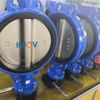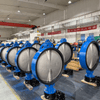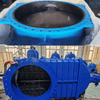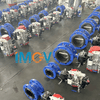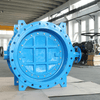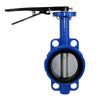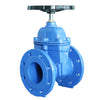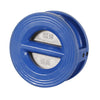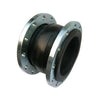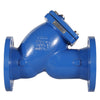Understanding Your Options: Soft Sealing vs Hard Sealing Butterfly
What is a soft seal butterfly valve?
1.Soft sealing Butterfly Valves
Soft Sealing Butterfly Valve A soft sealing butterfly valve refers to a valve where one side of the sealing pair is made of metal material and the other side is made of elastic non-metallic material. This type of sealing provides good sealing performance but is not resistant to high temperatures, wears easily, and has poor mechanical properties. Examples include steel + rubber and steel + PTFE.
The soft sealing seat is made of non-metallic materials with certain strength, hardness, and temperature resistance. It offers good sealing performance and can achieve zero leakage, but its lifespan and temperature adaptability are relatively poor.
The materials commonly used for the sealing surfaces of soft sealing butterfly valves include EPDM (ethylene propylene diene monomer rubber), NBR (nitrile butadiene rubber), VITON (fluoroelastomer), andPTFE (polytetrafluoroethylene) . These four different materials for soft sealing butterfly valves are suitable for different media in pipelines.
EPDM Seat
EPDM is suitable for temperatures ranging from -40°C to 120°C. Its advantages include ozone resistance, heat resistance, and aging resistance, making it the most commonly used seat material for soft sealing butterfly valves. In normal temperature and pressure conditions, it provides excellent sealing performance. Soft sealing butterfly valves with EPDM seats are suitable for media such as freshwater, wastewater, seawater, and slurry containing impurities. They are widely used in construction, power generation, and water conservancy fields.
NBR Seat
NBR is suitable for temperatures ranging from -30°C to 90°C. Its advantages include good oil resistance, abrasion resistance, heat resistance, and strong adhesion. However, it is not resistant to low temperatures, has poor ozone resistance, low insulation performance, and slightly lower elasticity. Soft sealing butterfly valves with NBR sealing surfaces are used for lubricating oil and engine oil. The most notable feature of this material is its excellent oil resistance, along with some abrasion and heat resistance. Soft sealing butterfly valves using NBR as the sealing surface material are suitable for oil media in petroleum pipelines. However, NBR is not suitable for freshwater and similar media due to its toxicity, which can harm human health.
VITON Seat
VITON generally has a temperature range of -20°C to 250°C. It has better high-temperature resistance than silicone rubber, excellent weather, ozone, and chemical resistance, but poor cold resistance. It can resist most oils and solvents, especially acids, aliphatic hydrocarbons, aromatic hydrocarbons, and animal and vegetable oils. It is suitable for sealing requirements in diesel engines, fuel systems, and chemical plants.

PTFE Seat
PTFE is a fluoroplastic suitable for temperatures ranging from -196°C to 200°C. Its advantages include excellent heat and cold resistance, and resistance to general chemical solvents and almost all liquids. Soft sealing butterfly valves with PTFE seats are primarily used in industries such as chemicals, refining, chemical fibers, phosphate fertilizers, non-ferrous metallurgy, acid production, and dyeing. They are suitable for highly corrosive media such as strong acids and bases.

Soft sealing butterfly valves typically feature a small size, light weight, and excellent sealing performance, achieving zero leakage. They can be used in various situations, and the choice of sealing material for the soft sealing butterfly valve should be based on the specific working conditions.
What is a hard seal butterfly valve?
2.Hard Sealing Butterfly Valve
A hard sealing butterfly valve refers to a valve where both sides of the sealing pair are made of metal materials or other relatively hard materials.
Hard sealing butterfly valves have an eccentric metal sealing structure. The composition of the sealing surface materials generally includes steel + steel, steel + copper, steel + graphite, steel + alloy steel (where the steel can also be cast iron, cast steel, or alloy steel, and may involve overlay welding or sprayed alloy).
This type of sealing has relatively poor sealing performance but is resistant to high temperatures, wear, and has good mechanical properties.

Structural Features of Hard Sealing Butterfly Valves:
- The triple eccentric design eliminates friction between the sealing surfaces, extending the valve's service life.
- Elastic sealing is achieved through torque.
- The clever wedge design of the hard sealing butterfly valve provides an automatic sealing function that tightens as it closes, offering compensatory sealing and zero leakage.
- By changing the material of the parts, hard sealing butterfly valves can be adapted to various media and can be lined for corrosion resistance.
What is the difference between soft seal and hard seal of butterfly valve?
Hard sealing is made of metal, which provides relatively poor sealing performance. Soft sealing cannot meet the process requirements for some corrosive materials, whereas hard sealing can address this issue. These two types of sealing can complement each other. In terms of sealing performance, soft sealing is relatively better, but the sealing performance of hard sealing has also improved to meet corresponding requirements.
Soft sealing has the advantage of good sealing performance but is prone to aging, wear, and has a shorter service life. Hard sealing has a longer service life but relatively poorer sealing performance compared to soft sealing.
The main structural differences are as follows:
- Structural Differences: Soft sealing butterfly valves are mostly centerline types, with large diameters adopting double eccentric designs. Hard sealing butterfly valves are mostly single eccentric, double eccentric, or triple eccentric.
- Temperature Resistance: Soft sealing is used in normal temperature environments, while hard sealing can be used in low, normal, and high temperature environments.
- Pressure: Soft sealing is commonly used in low to normal pressure conditions, while hard sealing can also be used in medium to high pressure conditions.
- Sealing Performance: Both soft sealing and triple eccentric hard sealing butterfly valves have good sealing performance. Triple eccentric butterfly valves can maintain good sealing in high pressure and high temperature environments.
Concluding Remarks
Given the above characteristics, soft sealing butterfly valves are suitable for bidirectional opening, closing, and regulation in ventilation and dust removal pipelines, as well as in industries such as water treatment, light industry, petroleum, and chemicals. Hard sealing butterfly valves are more commonly used in heating, gas supply, and environments involving gas, oil, and acidic or alkaline substances. Union Valves is a professional supplier of butterfly valves, offering various types and specifications. If you would like more information, please contact us as soon as possible.
Related Article:
- Triple Eccentric Butterfly Valve: Design Advantages and Working Principle
- What is a Double Eccentric Butterfly Valve?
- Unlocking Valve Efficiency: Concentric, Double, and Triple Eccentric Butterfly Valves Explained
- Understanding Butterfly Valve Seats: The Differences Between Hard, Soft and Rubber Lined


